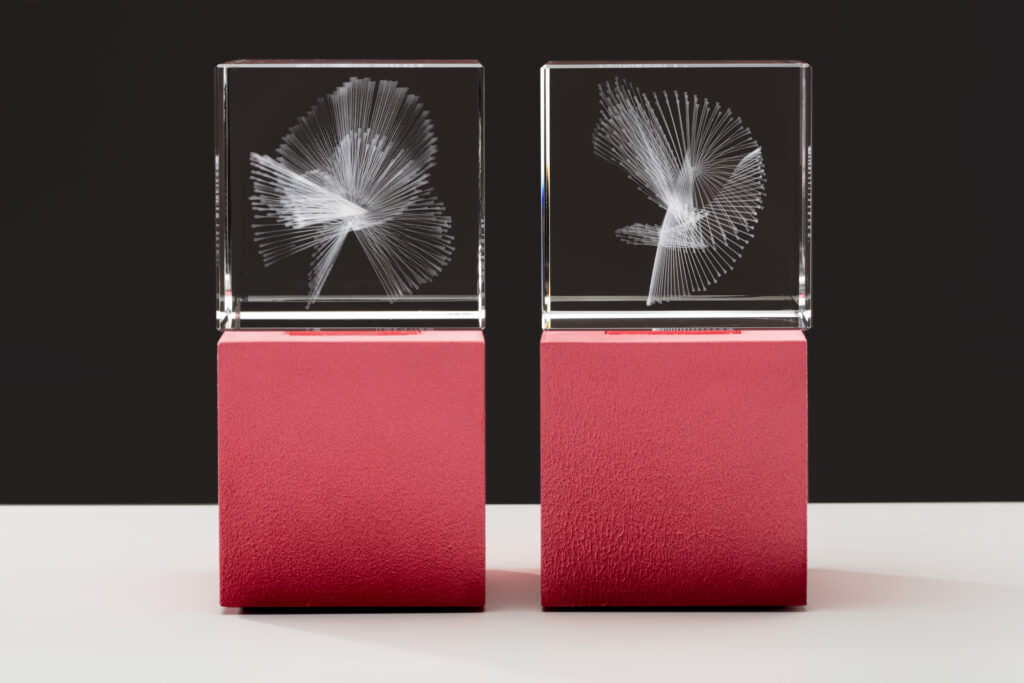The Rose Prize – Winners and Pressing Questions

The inaugural Rose Prize for Dance picked its winners but raised questions about the nature of dance today
The suspense is over: the winner of the main £40,000 Rose Prize for an established choreographer is Christos Papadopoulos from Greece for Larsen C.
The £15,000 Bloom Prize for an up-and-coming dance maker went to Stav Struz Boutros from Israel for Sepia. Both received crystal statuettes especially designed by Es Devlin (pictured top).
And now the questions start. Without wishing to take anything away from the winners – receiving their awards at Sadler’s Wells ceremony on Saturday evening both were suitably delighted, Boutros making her barely coherent ‘thank you’ speech through floods of tears – the decision was highly controversial.
As the chairman of the jury, Professor Christopher Bannerman, readily admitted, his four-person panel was faced with the impossible task of comparing “apples and oranges” and wildly diverging “visions”
To recap: nominators across all continents were asked to pick “the best” dance they had seen in the past two years. No further briefing, as Sir Alistair Spalding, CEO and Artistic Director of Sadler’s Wells, whose initiative this was, told Ballet Position, simply “the best.”
Note to the organisers: for future editions of this biennial prize, which hopes to acquire the international prestige of the Booker and the Turner, define your terms. Set clear parameters and brief your nominators accordingly. “Best” is simply not enough. Best of what?
Best of conceptual art? Performance art? Installation? Visuals? All this was present in some measure in the shortlisted works. But dance? Not so much… except in the piece that to my mind should have been the Rose winner: Kyle Abraham’s An Untitled Love.
Its African American pleasantly laid back vibe belied a tight structure. It was set to a medley of D’Angelo’s R & B/soul songs, and strikingly lit by Dan Scully. The ten dancers of A.I.M by Kyle Abraham lounged around talking about love, at intervals breaking into glorious dancing. There was humour, mischief and eroticism; but above all there was dance, a lot of it, the kind that makes your soul soar.
Should win? Undoubtedly. Did win? Sadly not.
The remaining three Rose contenders all had things in common, no least the kind of self-indulgence that leads works to go on and on and on for no good reason or discernible purpose.
The winner, Larsen C, which had the dubious distinction of earning a loud Boo! from a fed up audience member, was based on a visual concept inspired by distorting mirrors: take a monochrome set, darkly light it in now-you-see-now-you-don’t fashion (designer Eliza Alexandropoulo) and use industrial quantities of stage smoke. Stylish visuals first and foremost. Dance a very distant second.
Individual performers coalesced in an amoeba-like formation, that shuffled very slowly around the stage rather like the blob of a lava lamp. Not much actual dancing there; but the moment I saw it and much as it tried my patience (I would have taken 20 minutes of its 60), I sensed the judges would go for it. Cutting-edge, you see…
Both Carcaça, from Portugal’s Marco da Silva Ferreira, and Encantado, by the veteran Brazilian Lia Rodrigues relied on colour, folk accents and nudity. Of the two, Carcaça had the most actual dance, albeit of the repetitive up-down, up-down variety – had there been an award for sheer stamina, these dancers would have won hands down.
Encantado built from a very slow start (cue lots of coughing from the audience, a sure sign of boredom and restlessness) into a kind of tribal frenzy, build around mountains of colourful fabric with much flashing of tits and flaunting of (unappealing) genitals.
It was lively but unskilled and felt like it would never end.
I was less invested in the Bloom, so I guess Stav Struz Boutros’s intriguing inquiry into Balkans men’s folk dances and her attempt to fashion from them dances of femininity was as inoffensive a winner as any, though I would have preferred the sheer spunk and slightly demented overtones of Leïla Ka’s Maldonne, whose stupendous five dancers keep me hooked until the end.
That was not the case with the also very slow esoteric offering from Taiwan, Wang Yeu-Kwn/Simmering Productions’ Beings, whose dense cultural concept did not translate to the stage.
In short, this inaugural edition of the Rose Prize (backed by an anonymous donor) felt rather like a trial run. I hope for a better curated, more consistent and dance-focused edition in 2027.
© Teresa Guerreiro
(Banner image credits: Bloom & Rose © Juliet Sheath)
More info about the Rose Prize and the finalists here
